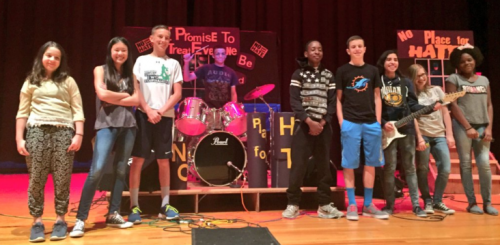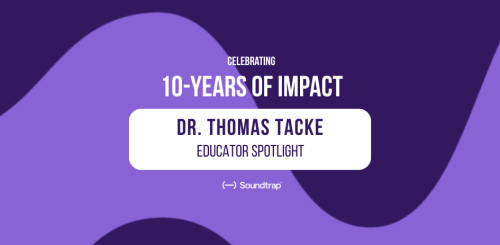
Connecting Soundtrap for Education & LMS for School
September 27, 2022Today’s students are digital natives, which means that our education systems and teaching methods must evolve to accommodate the changing needs of modern students. As a teacher, Learning Management Systems (LMS) are vital to successfully delivering online learning materials, especially if you’re responsible for many students.
The right LMS simplifies your process for organizing and distributing online learning materials, and cloud-based audio production software can integrate seamlessly with your preferred LMS to supercharge lesson plans in any subject area. Even if you’re not a music teacher, the positive impact of audio recording software in the classroom is indisputable. The ability to experiment with sound empowers students by providing a safe space to develop their unique voices while fostering a spirit of innovation.
Plus, when you can easily integrate this technology into your existing LMS, creating new, engaging lesson plans is a breeze! It’s time for teachers to enter the Digital Age and allow students to unleash their creativity with audio recording technology.
How Every Teacher Can Use Soundtrap for Education
Soundtrap for Education brings a spark of ingenuity to educators using LMS in schools. Integrating this revolutionary audio recording platform into your LMS allows students to collaborate with your guidance, even if you are separated in different locations. Educators can use Soundtrap to create secure, invite-only groups and assign projects in a walled digital environment.
Of course, when you hear about an audio recording platform, you may initially think this software is only beneficial for music teachers. On the contrary, teachers of all subjects and grade levels can seamlessly incorporate audio recording technology into their lesson plans, so every student has a better learning experience. Here’s how Soundtrap can benefit your students’ core skills!
Literacy
When elementary-aged students read, they’re engaging in a complex mental task that nurtures the development of new neural pathways in the brain. Adding phonics allows children to process this information more efficiently and understand the written word better. Research shows that phonics is one of the most productive ways to teach children how to read.
When young students experience the written word through sound, they begin to understand how literature connects with their everyday conversations. As students record their own voice and hear it play back, their reading fluency increases. Furthermore, they also develop confidence in their ability to read new words by sounding them out.
Music
Music education isn’t just about learning an instrument. A robust music curriculum integrated into an LMS supports overall learning through several secondary skills. These skills include pattern recognition, dexterity, creative thinking, and teamwork. It also offers stress relief, helping students cope with challenges in a healthy way.
The addition of music technology allows children and teens to experiment with sounds in new, exciting ways. Even elementary-aged students can record their favorite sounds and transform them into one-of-a-kind art pieces. However, the benefits of music technology in education span far beyond musical development. When music technology is accessible in the classroom, it enhances students’ language acquisition and motor skills and their ability to listen and speak effectively.
World Language
When learning a new language, students often find listening comprehension tasks the most challenging because native speakers often talk at a fast pace. However, these tasks encourage active listening, allowing students to understand a new language better. While listening to podcasts in another language can be effective, foreign language teachers can take foreign language education to the next level by encouraging students to create their own podcasts.
The best way for students to master a new language is by speaking it, but it’s vital to encourage communication and collaboration in ways that span beyond the rote memorization of common phrases. With cloud-based audio production technology, you can allow students to create their own podcasts in a foreign language. This way, students can develop confidence communicating in a new language through an engaging activity with real-world applications.
With audio tools, the ability for a student to record their voice and hear it in a new way can be an empowering experience. This is especially true for anxious children who have speech challenges or don’t speak English as their first language.
Science and Mathematics
For science teachers, it can be a struggle to create lesson plans that allow students to comprehend the nuance within complex, theoretical concepts, especially for students that require a hands-on approach. However, when science teachers provide another avenue for students to process and memorize scientific concepts, the world of science becomes more accessible to everyone. Since the relationship between music and science education is well-established, why not try a science lesson plan using audio technology to help students leverage music’s power to memorize and understand atomic structures?
When it comes to mathematics, students benefit significantly from learning about abstract concepts within the context of the real world. Students that struggle with math often find it challenging to understand how mathematical concepts relate to their lives. But the truth is that these rules are ever present in ways that students may not have considered before. When math teachers present abstract concepts like fractions within the relatable context of music, they begin to understand that math is all around us.
Technology and Business
If you’re a business teacher, it’s your responsibility to equip students with knowledge and skills that prepare them to thrive in the fast-paced world of entrepreneurship. Through project-based learning, business teachers create an environment where students can better understand how to create a viable business. Completing a group project allows students to learn about the importance of effective communication and collaboration in entrepreneurship while also encouraging students to devise creative solutions in the face of obstacles.
Burgeoning entrepreneurs must master these skills and learn how to sell a product or service to their ideal customers. With cloud-based music technology, you can introduce students to these concepts in an accessible manner by allowing them to create their own radio commercial for a real product.
Are You Ready to Get Started?
If you’re a teacher ready to bring music technology to the classroom, it’s easy to integrate Soundtrap with Noteflight and Flat.io so you can host online music classes. Additionally, you can integrate Soundtrap with LMS platforms like Canvas, Google Classroom, Schoology, and Musicfirst.
Luckily, getting started with Soundtrap for Education is as easy as these simple steps. Plus, we also have plenty of support resources and a Youtube channel, so your students can begin creating immediately! Check out our free trial today if you want to give Soundtrap a test run before you commit.
1. Add Your Students
Firstly, you’ll need to give all your students access to Soundtrap. You can grant students access from within Soundtrap by sharing an invitation link and their group code. Remember to activate the code before sending it! You’ll have the option to activate the code for 60 minutes or 30 days. These group codes ensure students have a safe, secure online learning environment.
Once students follow the link, they can create an account and set their password. Now, your students can work on assignments from any WiFi-connected device, even when they’re not in the classroom.
2. Create Student Groups
Whether you’re teaching mathematics, language arts, music, or another subject, you’ll need to divide your students into groups to ensure that their learning materials stay organized. You may organize student groups using any criteria that you see fit. This can include their class period, grade level, instrument type, or combination of these options. Regardless of how you organize your groups, placing students in small groups will enable them to more effectively collaborate with one another.
3. Create and Delegate Assignments
Once you’ve organized the student groups to your liking, you can begin creating assignments for your lesson plan. You will have the option to create a new assignment or share an existing assignment with your students. Soundtrap provides different ways to share assignments, including Google Classroom or Microsoft Teams. However, you can also share assignments with specific groups, and the most common method is simply sharing a link. Now, students can work on their projects in Soundtrap with any internet-connected device from any location.
4. Use Our Resources and Join Our Community
Interested in discovering new ways to use Soundtrap for Education in your classroom? We have a comprehensive resource portal to get your creative juices flowing. But that’s not all! You can also connect with other educators and take your teaching abilities to new heights with actionable insights directly from leaders in the educational industry. Moreover, you can use Soundtrap to further your own education with our professional development certificates and the Soundtrap EDU Summit. Soundtrap for Education unifies both educators and students through the power of sound.
Enhance Your Lesson Plans with Soundtrap for Education
Every student has a different learning style, and some aren’t well-suited to traditional teaching methods. With Soundtrap for Education, educators can create a learning environment where every student can thrive, no matter the subject.
Soundtrap for Education is the ultimate audio production platform for students and teachers to create and edit audio recordings. Both pupils and educators can easily tap into their artistic side with this intuitive audio platform. Soundtrap facilitates a creative learning environment for every subject, regardless of the student’s age or experience level.
With Soundtrap for Education, students and teachers can collaborate with advanced cloud technology at any time or place. In addition, the platform is equipped with a robust resource portal. The resource portal comes equipped with tutorials, an external curriculum, and lesson plans to complete the educational experience. And to ensure privacy, teachers can ensure that student collaboration is safe and secure with invite-only groups in Soundtrap’s versatile digital environment.
Ready to enhance your educational experience with an intuitive cloud-based audio production platform? Get started today with Soundtrap for Education! Share this article with other teachers in your network to help spread the joy of learning through sound.
 EDU Portal
EDU Portal


